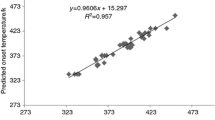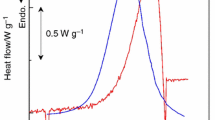Abstract
All thermal systems are subject to problems of thermal regulation. These can be understood through the use of thermochemical systems, in particular for those in the liquid phase. A dynamic linear model was earlier applied to obtain both the reaction enthalpy and the rate constant at constant temperature for the catalytic decomposition of hydrogen peroxide. This first model did not yield a good fitting between the calculated and experimental data. The hypothesis that the rate constant was independent of temperature was too strong.
In the present study, a more elaborate, non-linear model was developed, which takes into account the rate constant variations as a function of temperature (Arrhenius law). This model allowed the activation energy to be determined. The calculated data then successfully fitted the experimental data. The literature indicates that the first-order rate law is not valid for a certain range of concentrations; the present model verified this.
The results of dynamic modelling confirm and increase the precision of results obtained in different ways. The developed model is validated through these comparisons.
Similar content being viewed by others
References
N. Balbi, 'Modélisation dynamique de systèmes thermiques et thermochimiques. Application au stockage de l'énergie.' Thèse d'état, Université de Corse, 1988.
N. Balbi and B. Khoumeri, J. Thermal Anal., 42 (1994) 461.
N. Balbi, Bull. Soc. Chim. France No. 6, (1989) 753.
P. Hugo and W. Schaper, Ger. Chem. Eng., 3 (1980) 103.
W. G. Barb, J. H. Baxendale, P. George and K. R. Hargrave, Trans. Faraday Soc. 47 (1951) 591.
L. Bohnson and A. C. Robertson, J. Am. Chem. Soc., 45 (1923) 2493.
W. Schaper, Dissertation, TU Berlin, 1978.
B. Khoumeri, Modélisation des réactions thermochimiques — détermination dynamique des paramètres thermiques et cinétiques et applications, Thèse, Université de Montpellier, 1994.
M. Köppner, Studienarbeit, TH Darmstadt, 1964.
M. Sibony and J. Mardon, Approximations et équations différentielles, Ed. Hermann, 1982.
P. G. Ciarlet, Analyse numérique, calcul matriciel et optimisation, Ed. Masson, 1988.
Y. Berrah, Etude de différentes stratégies de modélisation de réactions dans un réacteur fermé en synthèse organique. Application à la réaction de cyanoethylation du malonate de diméthyle, Thèse de 3ème cycle, Université Lyon I, 1991.
W. Schumb, C. Satterfield and R. Wentworth, Hydrogen Peroxide, Reinhold, New York 1955.
Author information
Authors and Affiliations
Rights and permissions
About this article
Cite this article
Khoumeri, B., Balbi, N., Leoni, E. et al. The Decomposition of Hydrogen Peroxide. A non-linear dynamic model. Journal of Thermal Analysis and Calorimetry 59, 901–911 (2000). https://doi.org/10.1023/A:1010130510308
Issue Date:
DOI: https://doi.org/10.1023/A:1010130510308




